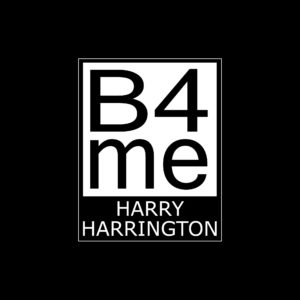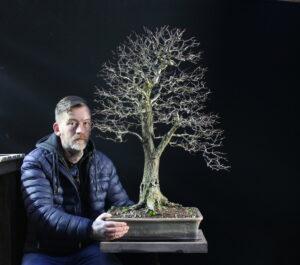This article describes the pruning of deciduous tree branches in Autumn. As the leaves fall in Autumn it is the first opportunity to study the branch structure in detail since the beginning of the growing season. However, it is possible to carry out these techniques at Midsummer if the tree is vigorous and suitable for defoliation.
It is important that enthusiasts in areas where their trees will be exposed to temperatures below around -7ºC apply these techniques in the Spring when the last of the severe cold has finished.
The horticultural principle behind this timing is that the branches and the tree itself do not become fully dormant until a few weeks after the leaves have fallen (new pruning wounds made during leaf-fall will noticeably begin to heal), and any tiny cracks and fractures made during wiring at this time will also have time to seal against the cold in the depths of Winter.
It may indeed be possible to carry out Autumn wiring and pruning in colder climates than my own, however without the necessary experience I cannot advise it.
Whenever these techniques are actually carried out, they are an important aspect of bonsai development and maintenance and should be applied at least every two years to keep a bonsai in pristine condition.
The primary objectives of Autumn/Winter pruning are:
1) the pruning back of new shoots to address the balance of the branches and to improve branch taper
2) shaping of the branches with wire to improve the placement of older branches and to place the previous years growth correctly.
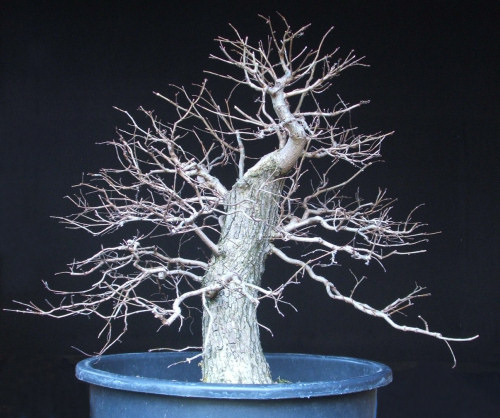
This is an Elm airlayer in Autumn 2009 with all of the remaining leaves removed. As can be seen in the image above, the bonsai now has an impressive number of branches (ramification). However, the branches have become messy and the true aesthetic form of the branch structure has been lost.
Within the branch structure there are also a number of branches that have ‘faults’; that is, branches whose improved appearance, or removal would improve the image of the bonsai overall.

When working on the entire structure of a bonsai, it is simplest and easiest to work methodically starting on the lowest branches and working up the tree towards the apex or crown.
Working from the bottom upwards is a good habit to get into for the enthusiast; the shape and style of the lowest branches should dictate that of the branches higher up the trunk and it is considerably easier to manipulate or even regrow the upper branches in accordance to the lower branches on a bonsai than vice-versa.
The lowest branch of the Elm airlayer has been allowed to grow freely during the growing season to encourage it to thicken.
Shoots such as these that have grown outside the silhouette of the tree are pruned back. Where there are more than two shoots growing from any one point, the extra shoots should be also be automatically removed.
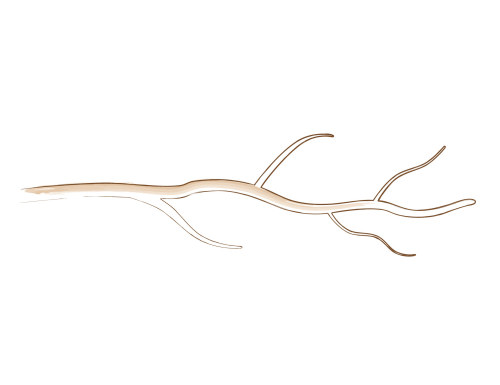
As an example, this is a branch that requires pruning back slightly so it is within the silhouette of the tree.
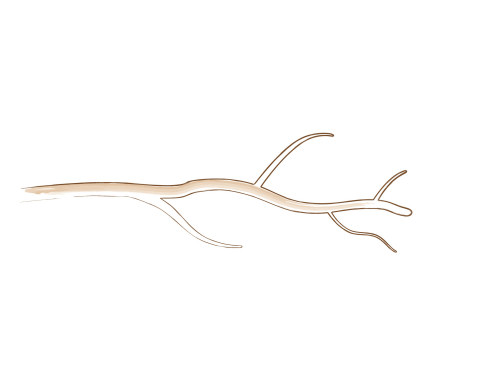
If the 3 branch tips are simply pruned back a little the branch will then have 3 branch tips but an opportunity to improve taper will be missed.
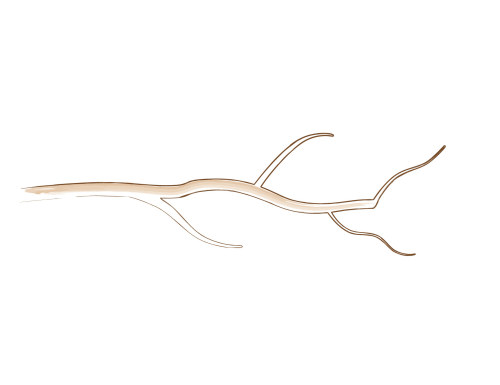
For better taper, the main branch line is pruned back to the side branches producing more refined branch tips.

For even better branch taper in the future, the branch could be pruned even further.
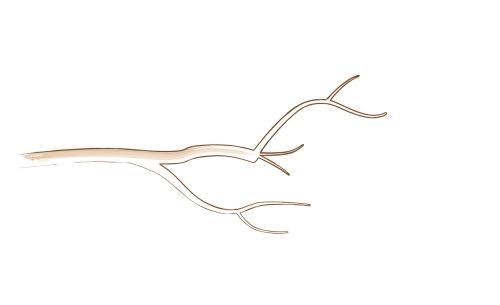
The resulting growth in the Spring will quickly fill out the structure of the branch, however, obviously the tree’s foliage mass will be thinner in the immediate future which is why pruning back this far would normally be reserved for trees in development.
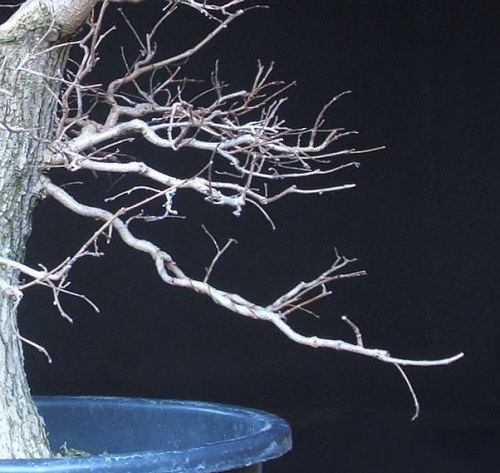
After pruning back all of the required shoots, the remainder are wired into shape where necessary.
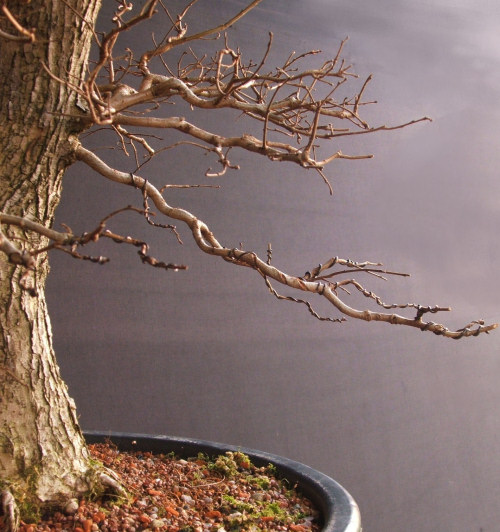
All new shoots (from the growing season that has just finished) that do not grow in the correct direction or are too straight are wired to add movement and direction to them.
This step is very much part of the artistic side of bonsai and the exact placement of the branches will depend on the individual.
Some enthusiasts prefer a ‘classical’ or ‘abstract’ style of deciduous bonsai and the majority of the branches will be downward growing.
Other enthusiasts prefer a more ‘naturalistic’ style of branch placement and will try to imitate nature by arranging the branches on a deciduous tree so that the lower branches will drop downwards from the trunk but then rise gently at the tips and the upper branches will automatically rise as can be seen on deciduous trees in the wild.
Whilst the exact styling of a bonsai is down to personal taste, my personal preference tends to be for more naturalistic styling and I would encourage enthusiasts to follow this direction and avoid the more primitive abstract styles of yesteryear.
AUTUMN/WINTER or STRUCTURAL WIRING AND PRUNING

This second example of autumn/winter pruning concerns a branch near the apex of the elm airlayer.
At first glance it is easy to see that the growth is too straight. Each of the shoots also needs to be positioned slightly lower into an area of the crown that is at present empty.
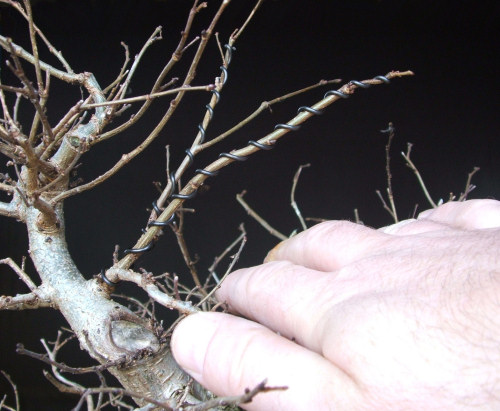
Straight growth, be it on trunks, branches or minor shoots, should always be avoided as they will always make a bonsai look immature whereas growth with plenty of (realistic) movement will add age and interest to a bonsai.
The first step is to quite simply coil bonsai training wire around the shoots of the branch.
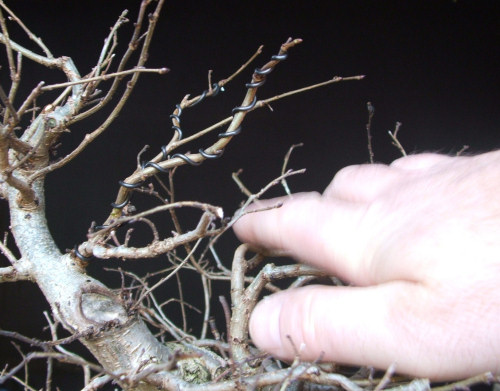
And then movement is added to the shoots by making them bend not only from side to side but also up and down.
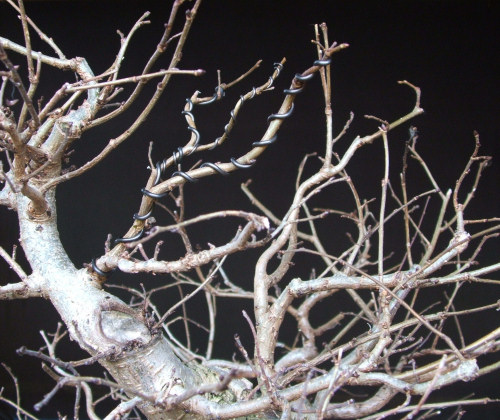
The final shoot has movement applied to it and now the 3 secondary branches in this area of the tree are finished for the time being.
Each of the shoots should not look exactly the same after they have been wired but they must have similar movement to eachother.
That is, they should look as though they have grown under similar circumstances to each other on the same tree but there must also be an element of randomness to their movement as well. Otherwise in the future, when the wire has been removed, it will be obvious that the shoots have been artificially placed.
One of the main purposes of wiring is to create the illusion to the viewer of the bonsai that the tree is a miniature version of one found in the wild and that the bonsai has grown naturally into shape by itself. Therefore, long term evidence of wiring and artificial placement need to be avoided.
Use twists and bends of similar degrees but in different combinations to achieve a random effect when placing newly wired branches.
Make sure that if the trunk has very heavy twists and turns this is reflected in the movement of the branches as well. Similarily, if the trunk has very slow, gradual bends, its branches should reflect this.
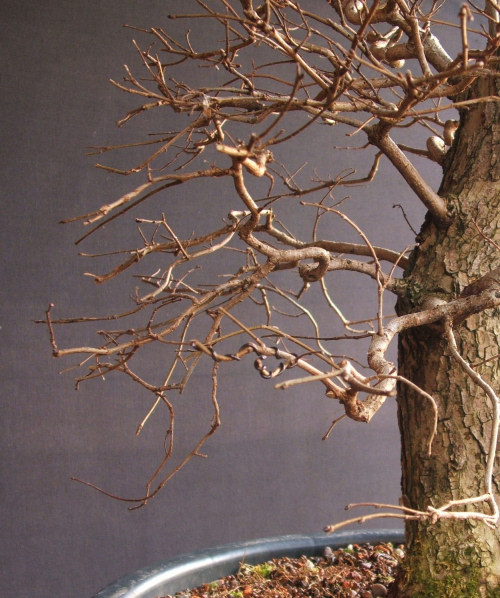
These are the lower left hand branches of the Elm airlayer. The older branch sections have been pruned and wired a number of times in the past but as is normal some of them have naturally lifted out of position while the new growth has not been shaped before and has no natural shape or pattern.
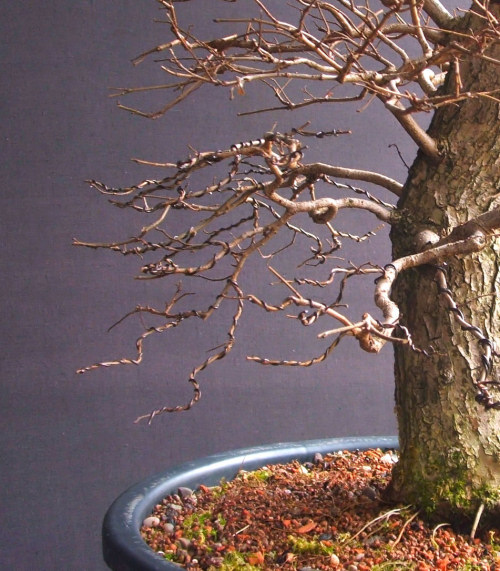
After wiring the new lower branches and rewiring those that have lifted out of shape, some order has been restored.
Straight shoots have had movement wired into them and have been placed so that they all grow outwards in their own space.
Notice that I have not tried to form a ‘cloud’ of foliage. ‘Clouds’ of foliage are something of a cliché in bonsai and should really only be considered on coniferous species where they would be found growing naturally. Rather, on deciduous trees, each of the leaves and shoots naturally grow into space where they can receive maximum light.
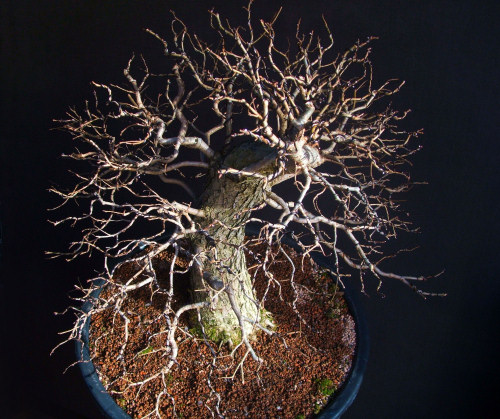
After many hours of pruning and wiring the branch structure has been arranged for another year.
Notice that when seen from above, the branches and individual shoots fan out into their own individual spaces. Although each branch has been individually wired and styled, they all combine to produce one cohesive design where no one particular branch or shoot looks out of place.
As noted before, Autumn/Winter styling is a time consuming process but it is not only an essential task but one that produces spectacular results, short- and long-term.

December 2009 After pruning and wiring the Elm airlayer.
December 2009: As can be seen in the image above, I have styled the Elm in a ‘naturalistic’ style. The branches avoid the clichés of all being placed on a horizontal plane and I have retained primary branches in such a way that they do not grow from the trunk in a left-right-back, left-right,back formation as used to be advised for the unnatural abstract styling of yesteryear.
Note that the apex has been shaped with a steep slope towards the right and gradual slope towards the left. This almost subconciously indicates to the viewer that the tree is growing towards the sun on the right hand side. This means that the first or primary branch also grows towards the right, despite not being the lowest branch. Additionally, the branches on the left hand side (the ‘shaded’ side of the tree) have a tendency to grow upwards, whereas the branches on the right hand side have a tendency to grow outwards towards the ‘sunny side’ of the tree.
These are all subtle visual clues that we all see in trees everyday and as bonsai enthusiasts, can harness to create a more convincing image for our bonsai.
There are many visual clues that we all use to give the impression of age in a tree. Short term solutions are to style the branches of a bonsai on a horizontal plane to give the impression of aged branches weighed down over time by the weight of the sub-branches or snow lying on them through the depths of winter. Or to allow a massive number of sub-branches to develop (ramification) to create a dense canopy of leaves. However, these short-term solutions cannot replace and should not be confused with the genuine characteristics of great age in a bonsai, taper.

